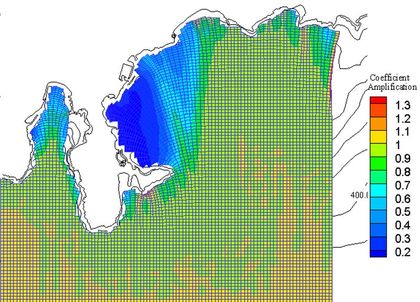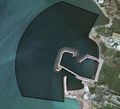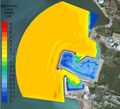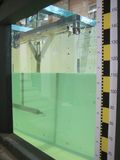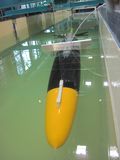Hydrodynamics
The topic of hydrodynamics covers all research performed to improve the
understanding and modeling of physical phenomena encountered in a marine
environment, such as waves, currents, interaction with ocean structures,
sediment transport. It naturally includes the continuous development,
starting in 1991, of our coastal wave agitation simulation software SIMAC.
It also includes our research in the field of optimizing unmanned mobile
subsea machines, or gliders, dedicated to collecting marine environment
data.
Internally developed SIMAC software
Since its creation, ACRI IN has developed a large
part of its calculation codes directly related to its areas of
expertise, especially in coastal hydrodynamics, to remain in the
forefront of digital simulation, notably concerning wave propagation
and the study of floating and submerged structure behavior under the
influence of swells. The design and development of the string of
software modules in SIMAC started in 1991, and it is still being
improved today. The two primary modules are:
- SIMAC-AGITATION : used to calculate harbor and coastal wave
agitation (Berkhoff equation, phase resolution, diffraction
effects, multiple reflections, refraction on variable
bathymetrics, spectral waves, three dimension
transmission/reflection effects caused by wave attenuators,
surge, etc.);
- SIMAC-POSEIDON : wave propagation from open water towards the
coast (spectral wave) considering the effects of diffraction and
refraction, and curvilinear mesh (phase resolution). Can be
coupled with the harbor and coastal wave agitation module.
ACRI-IN's R&D department also has upgraded the connection between
SIMAC-AGITATION and the propagation calculation code in REFDIF. This offers
the benefit of being fast and stable, and is an alternative to
SIMAC-POSEIDON for some study site configurations to which it is better
suited.
ACRI-IN has also deployed the means to develop settings interfaces (mesh,
boundary characteristics, data entry, etc.) and post-processing the results.
UNDERWATER GLIDER Design
The Sea-Explorer research project (sponsored by the
PACA Maritime Cluster), along with the Vasque research project
(co-sponsored by the PACA Maritime Cluster and the Risk Cluster),
were developed in partnership with companies (ACSA, ACRI-ST) and
public organizations (IFREMER, USTV, LOV, COM, CEDRE).
The objective of Project SeaExplorer is to design,
develop, test and then build a prototype underwater glider that is
strong enough to penetrate the ocean measurement market. This type
of remote machine, designed to consume the least amount of power,
has the ability to cover several hundreds, and even several thousand
kilometers of ocean, measuring targeted physical parameters of the
marine environment. This considerably reduces the cost of the
measurements compared to a traditional campaign on a special purpose
ship. In this configuration, the machine will be used to cross seas
and oceans, communicating its positions and potential warnings via
satellite.
The objective of the VASQUE research project is to
design a hybrid machine combining a glider with propulsion without
degrading its ability to penetrate to the ocean depths for an
optimum energy cost. The VASQUE project will complement the range of
SEA EXPLORER gliders. The originality of this machine compared to
existing machines is its ability to combine two motive forces.
ACRI-IN's contribution to the overall program consists of researching and
validating the machine's physical form and parameters to optimize its
capacity to "fly" and its propulsion.









